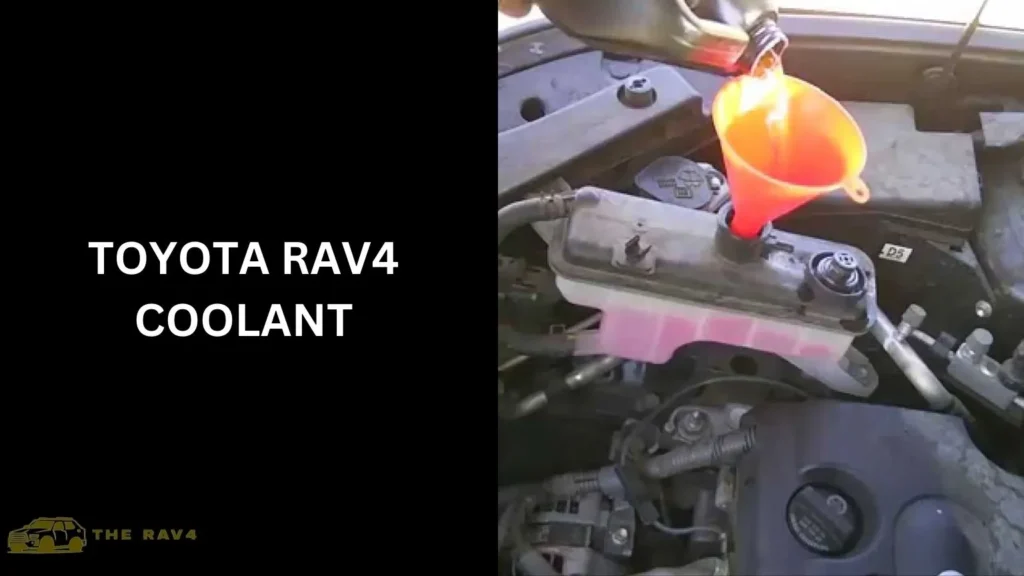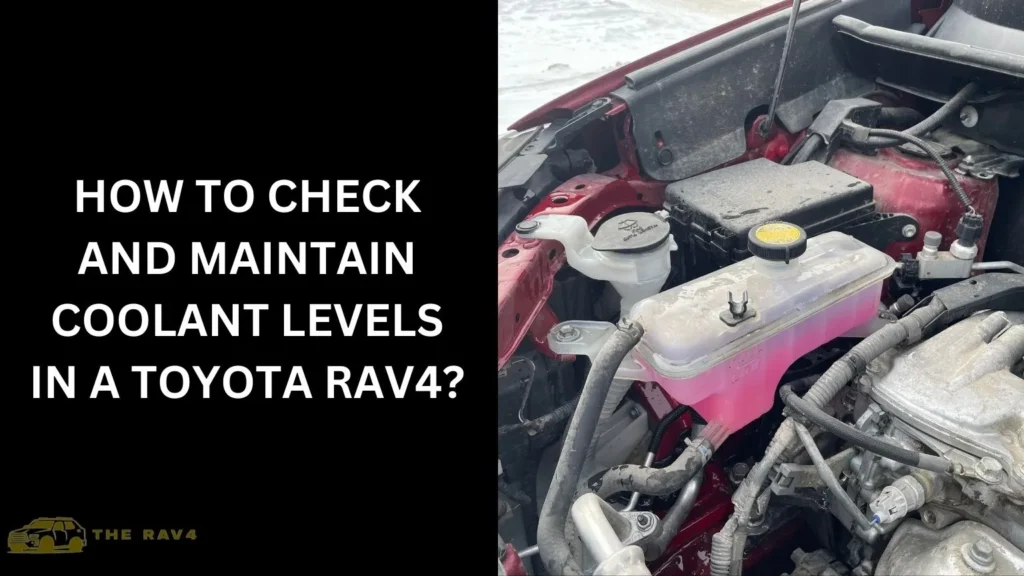In the world of automotive maintenance, one aspect that often gets overlooked but is crucial for the health and performance of your vehicle is the coolant.
Specifically designed for efficient heat transfer, coolant plays a vital role in keeping your Toyota RAV4’s engine running smoothly.
Let’s delve into the world of Toyota RAV4 coolant, exploring its importance, maintenance, and common issues.

Importance of Proper Coolant Maintenance
Proper coolant maintenance is vital for the health and performance of your vehicle’s engine. It plays a crucial role in managing engine temperature, preventing overheating, and protecting engine components from corrosion and damage.
Here are key reasons why maintaining your vehicle’s coolant system is essential:
Engine Cooling System Basics
The engine cooling system is responsible for regulating the temperature of your Toyota RAV4’s engine, ensuring it operates within optimal parameters. Coolant, also known as antifreeze, plays a dual role in this system. It absorbs heat generated by the engine and dissipates it through the radiator, preventing overheating.
Coolant Types for Toyota RAV4
Toyota recommends using the appropriate coolant type for your RAV4, typically a mix of water and ethylene glycol. This coolant not only prevents freezing in cold temperatures but also inhibits corrosion and lubricates the water pump.
Signs of Coolant Issues in a Toyota RAV4
Coolant plays a crucial role in keeping your Toyota RAV4’s engine operating at optimal temperatures.
However, several signs may indicate potential coolant problems that need attention. Being aware of these signs can help you address issues promptly and prevent engine damage.
Here are common signs of coolant issues in a Toyota RAV4:
Overheating Engine
One of the most apparent signs of coolant problems is an overheating engine. If you notice that your RAV4’s temperature gauge is consistently in the red zone or climbing higher than normal, it indicates that the engine is not being adequately cooled.
This could be due to low coolant levels, a coolant leak, a malfunctioning thermostat, or a faulty cooling fan.
Coolant Leaks
Visible coolant leaks under your vehicle or around the engine area are clear indicators of a coolant issue.
The coolant may appear as a colorful fluid (often green, pink, or orange, depending on the type of coolant used).
Leaks can occur due to damaged hoses, a cracked radiator, a faulty water pump, or a corroded coolant reservoir. Addressing leaks promptly is crucial to prevent engine overheating and potential damage.
Steam or Smoke from the Engine
If you notice steam or smoke coming from under the hood while driving or after parking, it could be a sign of coolant leaking onto hot engine components.
This situation requires immediate attention, as it indicates a significant coolant leak that can lead to engine overheating and potential safety hazards.
Low Coolant Levels
Regularly check your RAV4’s coolant reservoir to ensure that the coolant level is within the recommended range.
A sudden drop in coolant levels without any visible leaks indicates a potential internal leak, such as a blown head gasket. Ignoring low coolant levels can result in engine overheating and costly repairs.
Discolored Coolant
Inspect the color and condition of your RAV4’s coolant regularly. Fresh coolant is usually bright in color and clear.
If you notice that the coolant has become muddy, rusty, or contaminated, it indicates a problem within the cooling system, such as corrosion or mixing of incompatible coolant types. In such cases, flushing and replacing the coolant is necessary.
How to Check and Maintain Coolant Levels in a Toyota RAV4?

Checking Coolant Level
Start by ensuring your RAV4’s engine is cool. Locate the coolant reservoir and check the level against the markings on the reservoir. If it’s below the minimum mark, it’s time to add coolant.
Adding Coolant Safely
When adding coolant, always use the recommended type specified in your owner’s manual. Mix coolant with water as per the manufacturer’s guidelines and slowly pour it into the reservoir to avoid air bubbles.
Flushing and Replacing Coolant
Periodically flushing and replacing coolant is essential for maintaining optimal performance. Follow your vehicle’s maintenance schedule or consult a professional mechanic for this task.
Tips for Preventing Problems of Toyota RAV4 Coolant
Proper maintenance of your Toyota RAV4’s coolant system is essential to ensure optimal engine performance and longevity.
By following these preventive tips, you can reduce the risk of coolant-related issues and keep your vehicle running smoothly:
Regular Maintenance Checks
Perform regular inspections of your RAV4’s cooling system, including hoses, clamps, the radiator, and the coolant reservoir.
Look for signs of leaks, corrosion, or damage. Addressing minor issues early can prevent them from developing into major coolant problems.
Check Coolant Levels
Monitor the coolant level in the reservoir regularly, especially before long trips or during extreme weather conditions.
Ensure that the coolant level is within the recommended range indicated on the reservoir. Top up coolant as needed with the appropriate type specified in your owner’s manual.
Use Recommended Coolant
Always use the coolant type recommended by Toyota for your RAV4. Using the wrong coolant can lead to compatibility issues, corrosion, and reduced cooling effectiveness.
Follow manufacturer guidelines for mixing coolant with water, if necessary, to maintain the correct coolant concentration.
Flush and Replace Coolant
Periodically flush and replace the coolant according to your vehicle’s maintenance schedule or manufacturer recommendations.
Over time, coolant can become contaminated or lose its effectiveness, leading to cooling system problems. Flushing the system removes old coolant and debris, ensuring optimal performance.
Address Cooling System Issues Promptly
If you notice any signs of coolant leaks, overheating, or discolored coolant, address the issue promptly. Ignoring coolant problems can lead to engine damage and costly repairs.
Have a professional mechanic inspect and repair cooling system issues to ensure proper functioning.
Maintain Proper Engine Temperature
Avoid driving your RAV4 under severe conditions that can strain the cooling system, such as extended idling in hot weather or towing heavy loads without proper cooling system preparations.
Maintaining a consistent engine temperature helps prevent coolant-related issues.
People also ask
What kind of antifreeze goes in a Toyota RAV4?
Toyota recommends using a specific type of coolant for the RAV4, typically a mix of water and ethylene glycol.
This coolant is designed to prevent freezing in cold temperatures, inhibit corrosion, and lubricate the water pump.
Always check your owner’s manual for the exact coolant specifications for your RAV4 model.
Does Toyota take special coolant?
Yes, Toyota vehicles like the RAV4 typically require a specific coolant recommended by the manufacturer.
It’s essential to use the recommended coolant type to ensure compatibility, prevent corrosion, and maintain optimal engine performance.
Always refer to your owner’s manual for the correct coolant specifications for your Toyota vehicle.
What is the pink fluid in RAV4?
The pink fluid in a Toyota RAV4 is likely the coolant/antifreeze. Toyota often uses a pink-colored coolant in their vehicles,
which is a mix of water and ethylene glycol with additives to prevent freezing, inhibit corrosion, and lubricate the cooling system components.
Where is the coolant in a Toyota RAV4?
In a Toyota RAV4, the coolant is typically stored in the coolant reservoir, which is located near the engine compartment.
It’s a translucent or opaque plastic tank with markings indicating the minimum and maximum coolant levels.
Conclusion
Proper coolant maintenance is a fundamental aspect of keeping your Toyota RAV4 running smoothly and efficiently.
By understanding the importance of coolant, recognizing signs of coolant issues, and following recommended maintenance practices, you can ensure your RAV4’s engine stays cool under any conditions.